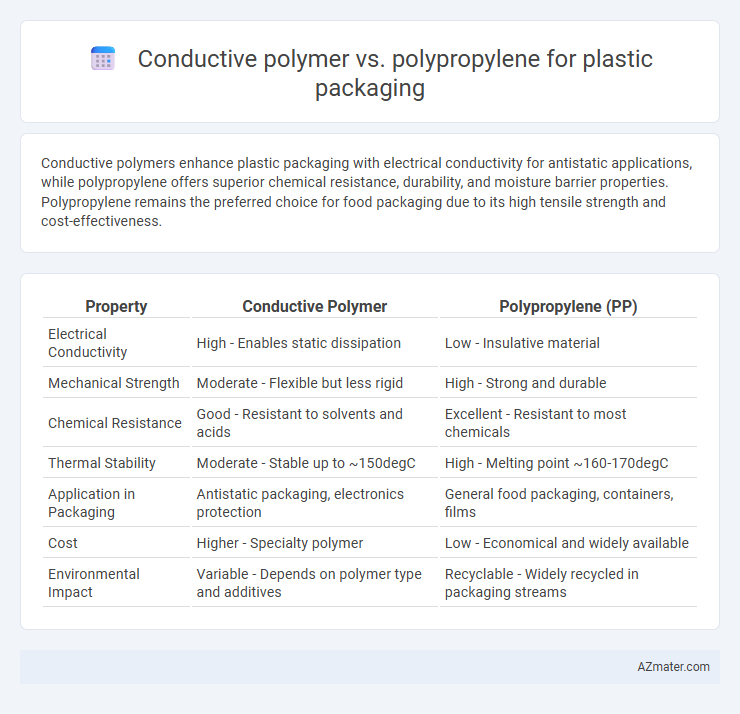Conductive polymers enhance plastic packaging with electrical conductivity for antistatic applications, while polypropylene offers superior chemical resistance, durability, and moisture barrier properties. Polypropylene remains the preferred choice for food packaging due to its high tensile strength and cost-effectiveness.
Table of Comparison
| Property | Conductive Polymer | Polypropylene (PP) |
|---|---|---|
| Electrical Conductivity | High - Enables static dissipation | Low - Insulative material |
| Mechanical Strength | Moderate - Flexible but less rigid | High - Strong and durable |
| Chemical Resistance | Good - Resistant to solvents and acids | Excellent - Resistant to most chemicals |
| Thermal Stability | Moderate - Stable up to ~150degC | High - Melting point ~160-170degC |
| Application in Packaging | Antistatic packaging, electronics protection | General food packaging, containers, films |
| Cost | Higher - Specialty polymer | Low - Economical and widely available |
| Environmental Impact | Variable - Depends on polymer type and additives | Recyclable - Widely recycled in packaging streams |
Introduction to Conductive Polymers and Polypropylene
Conductive polymers, such as polyaniline and polypyrrole, exhibit electrical conductivity combined with the mechanical properties of plastics, enabling applications in antistatic packaging and flexible electronics. Polypropylene, a widely used thermoplastic polymer, offers excellent chemical resistance, high tensile strength, and moisture barrier properties, making it a popular choice for conventional plastic packaging. The fundamental difference lies in polypropylene's insulating nature versus conductive polymers' capability to dissipate static charge, impacting their suitability based on packaging requirements for static sensitivity or durability.
Chemical Structure and Composition Comparison
Conductive polymers, such as polyaniline and polypyrrole, feature conjugated p-electron systems that enable electrical conductivity, contrasting with polypropylene's saturated hydrocarbon chains composed primarily of repeating propylene monomers (C3H6). The chemical structure of conductive polymers includes alternating single and double bonds facilitating electron delocalization, whereas polypropylene's non-conjugated structure results in electrical insulation and chemical inertness. This fundamental difference in molecular composition influences their suitability for applications requiring conductivity versus barrier and mechanical strength in plastic packaging.
Electrical Conductivity: Key Differences
Conductive polymers exhibit significantly higher electrical conductivity compared to polypropylene, which is an electrical insulator with conductivity near 10^-16 S/cm. These polymers facilitate electron transport due to their conjugated molecular structure, enabling applications in antistatic and electromagnetic interference shielding packaging. Polypropylene lacks this conjugation, resulting in poor electrical conductivity unsuitable for such functional packaging needs.
Mechanical Properties: Strength and Flexibility
Conductive polymers exhibit moderate mechanical strength and enhanced flexibility, making them suitable for applications requiring lightweight and bendable packaging materials. Polypropylene offers superior tensile strength and excellent impact resistance, providing robust and durable packaging solutions. While conductive polymers enable electrical conductivity and flexibility, polypropylene dominates in mechanical robustness and resistance to deformation under stress.
Barrier Properties: Moisture and Gas Resistance
Conductive polymers exhibit moderate moisture and gas barrier properties, often enhanced with additives, but generally lag behind polypropylene, which provides superior resistance to water vapor and oxygen transmission due to its highly crystalline structure. Polypropylene's low permeability makes it a preferred choice for plastic packaging applications requiring robust barrier performance against moisture and gases, thereby extending product shelf life. Advances in conductive polymer formulations aim to improve their barrier effectiveness, but polypropylene remains the industry standard for optimal moisture and gas resistance in packaging.
Applications in Plastic Packaging
Conductive polymers are utilized in plastic packaging primarily for their antistatic properties, ensuring protection of sensitive electronic components by dissipating static charges. Polypropylene dominates the packaging industry due to its excellent moisture barrier, chemical resistance, and cost-effectiveness, making it ideal for food containers, medical packaging, and consumer goods. While conductive polymers enhance functionality in niche applications requiring electrical conductivity, polypropylene remains the preferred material for general-purpose plastic packaging due to its durability and versatility.
Cost Analysis: Conductive Polymer vs Polypropylene
Conductive polymers generally have higher material and processing costs compared to polypropylene due to their specialized synthesis and conductive additives. Polypropylene remains the more cost-effective choice for large-scale plastic packaging applications because of its low raw material price and established manufacturing infrastructure. Evaluating lifecycle costs, polypropylene offers better economic efficiency, whereas conductive polymers justify their premium through enhanced functionalities such as antistatic properties.
Environmental Impact and Recyclability
Conductive polymers offer advanced functionalities such as antistatic and electromagnetic interference shielding but generally possess limited recyclability and higher environmental impacts due to complex chemical structures and less developed recycling streams. Polypropylene (PP) is widely used in plastic packaging for its excellent recyclability, lower carbon footprint, and abundant availability in recycling facilities, making it more environmentally sustainable for large-scale applications. While conductive polymers serve niche high-performance needs, polypropylene remains the preferred choice for eco-friendly packaging solutions due to its balance of durability, ease of recycling, and lower environmental burden.
Safety and Regulatory Considerations
Conductive polymers offer enhanced electrostatic discharge (ESD) protection, making them suitable for sensitive electronic packaging while complying with RoHS and REACH regulations due to their non-toxic additives. Polypropylene is widely recognized for food-safe applications, meeting FDA and EFSA standards, but lacks inherent conductivity, potentially limiting its use in ESD-sensitive packaging. Both materials must undergo rigorous testing to ensure compliance with migration limits and mechanical safety standards for their respective packaging uses.
Future Trends in Packaging Materials
Conductive polymers offer innovative advantages for plastic packaging by enabling smart functionalities such as anti-static properties and enhanced electrical conductivity, which support the development of interactive and protective packaging solutions. Polypropylene remains a staple in packaging due to its excellent mechanical strength, chemical resistance, and cost-effectiveness, but future trends show a growing integration of conductive polymer composites to improve recyclability and sustainability. Advances in biodegradable conductive polymers and polypropylene blends are driving eco-friendly packaging innovations that meet increasing regulatory demands and consumer preferences for sustainable materials.

Infographic: Conductive polymer vs Polypropylene for Plastic packaging
 azmater.com
azmater.com